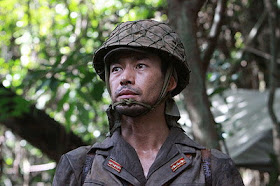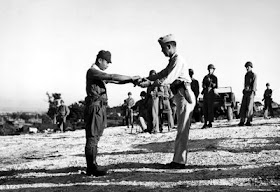The man the US Marines would call "Fox," Captain Oba Sakae was a school teacher who taught geography before becoming an officer in the Japanese Imperial Army. Assigned to the 18th Infantry, he was deployed at the outbreak of the Second Sino-Japanese War in Manchugo (Manchuria) in 1937. He had left for war with a wife named Mineko and an unborn son he would possibly never see. As the Japanese Empire began to collapse, the 18th Infantry was re-deployed from Manchugo to the Pacific when the ship he was aboard the Sakito-maru was torpedoed by the American Submarine USS. Trout. The ship sank with over half of the 18th Regiment. Captain Oba was among those lucky enough to have survived and reach the shores of Saipan. Having lost half his regiment, Captain Oba was placed in charge of a combat medical unit when 70,000 US Marines landed at Saipan battering the 30,000 Japanese defenders. Once again, Oba had managed to survive but his troubles were not over yet. As the situation on Saipan had deteriorated, the Japanese commanders were informed that the Combined Fleet of the Imperial Japanese Navy was destroyed and Saipan was to be abandoned. With no rescue in sight, their officers committed suicide and left the remaining junior officers to make one last Banzai charge insuring complete destruction of their forces. Over 4300 Japanese Soldiers died killing 2000 US Marines yet somehow Oba survived again. In July 9th, 1944. The USMC commander declared Saipan pacified. The only problem was someone forgot to tell Captain Oba.
Captain Oba would return home to Japan to see his son for the first time. His son was nine years old before he would meet his father. When you hear of present day war deployment stresses on families, one can not begin to imagine what these Japanese Soldiers and their families went through not seeing each other for years at a time. Captain Oba would go on to have a long successful career as a company spokesman for a department store and city council member before his passing in 1992. What is remarkable about this little known story is how this story came about. A former US Marine by the name of Don Jones who was once ambushed by Oba's men became fascinated with his story and tracked him down in post war Japan. With Oba's cooperation, Jones would go on to write his story and the two became life long friends. Even more remarkable was that Jones would later track down former Lt. Colonel Howard Kurgis and convinced him to give back the sword Oba had surrendered. The sword is now an Oba family heirloom. We are thankful to Don Jones for not only writing this remarkable true story but also Oba's second son Hisamitsu who discovered over 1200 pages, letters, and postcards of correspondence. He was so moved by his fathers letters who sought out a publisher and produced the novel Miracle of the Pacific the Man called Fox to which made it possible for a full length feature film to come out of it in 2010.
While the sinking of the Sakito-Maru is not mentioned in the film Oba The Last Samurai, we join the film recreating the real life events on Saipan just before the final Banzai charge. Played by Yukata Takenouchi, we revisit the desperate days following the annihilation of the Japanese garrison at Saipan. This film also stars Mao Inoue in the prominent civilian role of camp medic. She is tasked with tending to both the sick & wounded on an island with no natural water source. Other Japanese actors recreate the hardships of the many civilians that his out with Oba's men and those sequestered in the American camps. Daniel Baldwin plays Saipan's first enigmatic gung-ho Marine commander who sought to hunt and destroy the remaining Japanese on Saipan. Veteran actor Treat Williams would later play Kurgis the more mild mannered commander who replaces Baldwin.

Williams portrayal of Kurgis is done with a level of reason mostly due to the efforts of the Captain Lewis played by Sean McGowan. US Marine Captain Lewis is a man who spent two years in Japan prior to the war and is well versed if not sympathetic to Japanese Culture. He speaks fluent Japanese and is the only one who understands the Bushido mindset the Japanese operate under.
As a writer and aspiring novelist I enjoyed the addition of the Captain Lewis character. He provides insights into Japanese culture not only to his commanders but to the movie going audiences as well. His character also plays the good side of our US Servicemen. In war they say there is good and bad on both sides to any conflict. The Captain Lewis character does just that and in doing so he helps bridge the cultural divide between himself and Captain Oba whose motivations both baffle and frustrate the Marines. There are many human scenes that Yukata Takenouchi would play out. His portrayal of Captain Oba is most outstanding in it's realism and human dignity Takenouchi brings to the character. It is throughout the film in small gestures and selfless sacrifice that Oba comes through as a modern man free of the feudalistic thought that left no room for the living. Takenouchi brings this to life as one could imagine the real Oba Sakae did during thier 512 day campaign of resistance and survival. As Japan comes to terms with it's war time past in the form of recent big budget movies, this is one film of not only one remarkable man but of two who saved lives in a time when the philosophy of war guaranteed no survival or consideration of those left living. It is one thing to take responsibility for failure by commuting hari-kiri but a larger and even greater task to show greater leadership in the face of certain defeat and continue living.
We at American Mishima admire Captain Oba and the efforts of those both real and fictional who helped bring this story to the world.
We hope that in time, Oba and his 46 men will be remembered with such honor as another 47 Ronin are celebrated today. Think about it. 47 Japanese Soldiers outwitting over 47,000 US Marines for 512 days!
But don't take my word for it. Please see this movie and enjoy.








Great article, I was looking to learn more about the movie before i watch it and i felt like i just did.
ReplyDeleteI was afraid it was gonna be just another review, but i got sucked into the story pretty quick seeing it was really interesting.
I love japanese and history and movies so this site is going on top of my bookmark list.
Keep it up ;)
Domo Arigatou Gozaimasu! We love great movies and love to share them with you here on American Mishima. Thank you for reading!
ReplyDelete